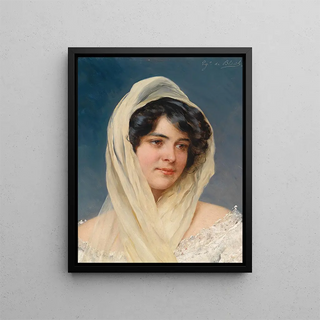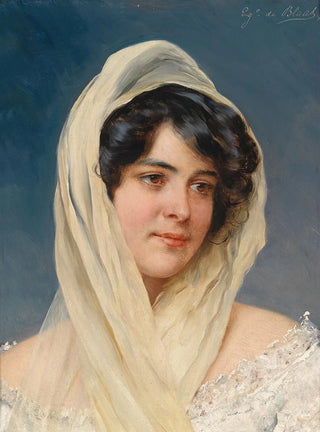Art print | Portrait of a young woman with a veil - Eugen von Blaas


View from behind

Frame (optional)
Portrait of a young woman with a veil - Eugen von Blaas – Captivating introduction
In the fascinating universe of art, some works manage to capture the very essence of humanity, transcending time and space. "Portrait of a young woman with a veil - Eugen von Blaas" is one of those creations that evoke delicate beauty and striking emotional depth. This canvas, both mysterious and luminous, invites the viewer to immerse themselves in a world where femininity is celebrated with infinite tenderness. The veil, a symbol of mystery and protection, adds an extra dimension to this portrait, arousing curiosity and admiration. In this work, every detail is carefully thought out, each brushstroke demonstrating a technical mastery that can only inspire awe.
Style and uniqueness of the work
Eugen von Blaas's style is distinguished by its striking realism and meticulous attention to detail. In "Portrait of a young woman with a veil," the artist manages to capture not only the physical appearance of his model but also her inner essence. The play of light on the veil and the face of the young woman creates an atmosphere that is both intimate and poetic. The soft colors and delicate nuances give the composition a lightness that contrasts with the depth of the emotions it conveys. The pose of the young woman, slightly tilted, along with her contemplative gaze, invites the viewer to wonder about her thoughts and dreams. This portrait is not merely a representation; it is an invitation to feel, to contemplate, and to marvel at the ephemeral beauty of life.
The artist and his influence
Eugen von Blaas, 19th-century Austrian painter, is renowned for his ability to immortalize female beauty through portraits imbued with sensitivity. Trained in the academic tradition, he mastered the techniques of the masters while developing a personal style that is uniquely his own. His work is marked by a fascination with Venetian culture, where he spent much of his life. This influence is evident in the way he approaches his subjects, often dressed in traditional costumes, immersed in atmospheres charged with history. Blaas was able, through his

Matte finish

View from behind

Frame (optional)
Portrait of a young woman with a veil - Eugen von Blaas – Captivating introduction
In the fascinating universe of art, some works manage to capture the very essence of humanity, transcending time and space. "Portrait of a young woman with a veil - Eugen von Blaas" is one of those creations that evoke delicate beauty and striking emotional depth. This canvas, both mysterious and luminous, invites the viewer to immerse themselves in a world where femininity is celebrated with infinite tenderness. The veil, a symbol of mystery and protection, adds an extra dimension to this portrait, arousing curiosity and admiration. In this work, every detail is carefully thought out, each brushstroke demonstrating a technical mastery that can only inspire awe.
Style and uniqueness of the work
Eugen von Blaas's style is distinguished by its striking realism and meticulous attention to detail. In "Portrait of a young woman with a veil," the artist manages to capture not only the physical appearance of his model but also her inner essence. The play of light on the veil and the face of the young woman creates an atmosphere that is both intimate and poetic. The soft colors and delicate nuances give the composition a lightness that contrasts with the depth of the emotions it conveys. The pose of the young woman, slightly tilted, along with her contemplative gaze, invites the viewer to wonder about her thoughts and dreams. This portrait is not merely a representation; it is an invitation to feel, to contemplate, and to marvel at the ephemeral beauty of life.
The artist and his influence
Eugen von Blaas, 19th-century Austrian painter, is renowned for his ability to immortalize female beauty through portraits imbued with sensitivity. Trained in the academic tradition, he mastered the techniques of the masters while developing a personal style that is uniquely his own. His work is marked by a fascination with Venetian culture, where he spent much of his life. This influence is evident in the way he approaches his subjects, often dressed in traditional costumes, immersed in atmospheres charged with history. Blaas was able, through his






